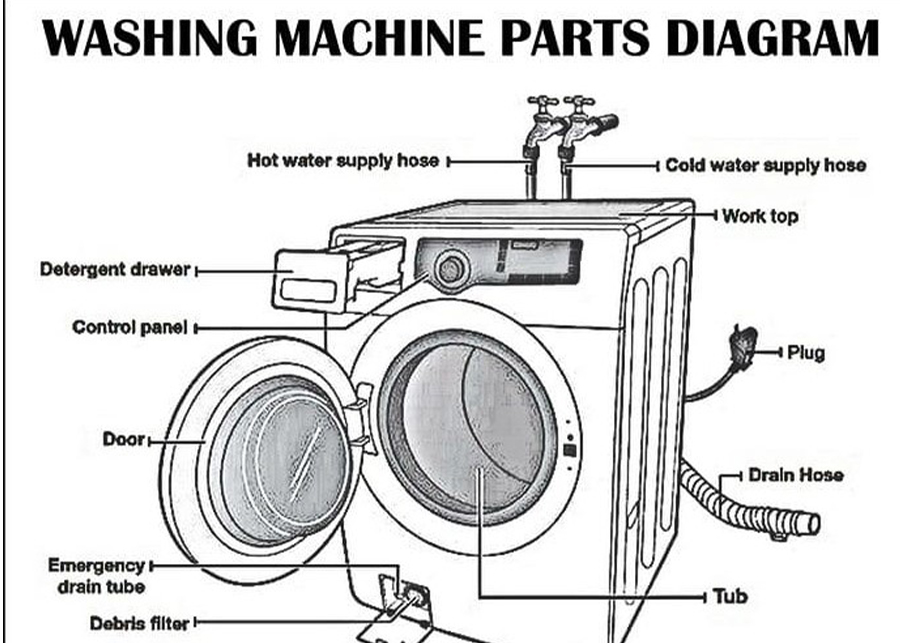In order to understand how a washing machine is made, it’s crucial to first understand a washing machines anatomy. Washing machines have multiple components that must be built separately and subsequently assembled together. A common washing machine, also known as electric washing machine, has inner works and outer housing or shell. The inner works consist of the tub, drum, pump motor and transmission. The outer housing is made up of 8 parts and includes the door, front panel, control panel and kick plate.
The manufacturing process of a washing machine includes fabrication, sub-assembly, and assembly. The fabrication process consists of a number of procedures specific to the raw materials used, such as sheet metal, plastic, or aluminum. Assemblies of the constituent parts are then completed. Major sub -assemblies include the transmission, pump, spin and wash tubs, and balance ring. The shell, or main body of the washing machine, contains the painted parts.

Basic washing machine features
There are many basic washing machine features you should look for. These include different washing cycles, dispensers for bleach and softener, end of cycle signals, and more. To make the most of your machine, learn how to use them and know which ones work best for your particular needs. Read the manufacturer’s manual for more details. Below is a list of important features to look for. Listed below are a few of the most common features found on washing machines.
Design
This thesis studies the front cover and tripod of a washing machine to optimize their performance and reduce the risk of damage. The main components are described in figure 1.1. A recent cylinder modification by ASKO has made it necessary to redesign the washing machine. These changes have a significant impact on the performance of washing machines. To solve this problem, reverse engineering and 3D printing are used. By collecting the origin point cloud information from an optical laser scanner, a 3D model of the improved washing machine is obtained. The model is then refined and the result is a product that meets the requirements.
Functions
If you are a beginner to learning the functions of a washing machine, you will first need to understand the basic parts of a washing machine. A washing machine has many different parts, but they all share a few common features. A washing machine’s main parts include a lid, an inner tub, and a series of vertical blades and rims. These components all play important roles in the process of washing clothes.
Costs
Consumers can pay anywhere from $400 to $ 1,700 for an average-sized front-load washer. Smaller units cost around $ 300 while high-end models cost up to $2,000. Prices vary greatly by region and zip code. Here are some tips for finding the best washer at the lowest price. Also, consider the type of washing machine you need. A front-loading machine is more expensive than a top-loading one, so consider your preferences and your budget.
Stackable models
Stackable washing machine models are great for small spaces. They can fit neatly into a closet and can be hidden for aesthetic reasons. Some are front -loading, which means they use less energy and water than top-loading models. And front-loading washers reduce drying time and energy use by spinning clothes faster. And you can get additional functionality by choosing front -loading models. Here are some of the top features to look for in stackable washing machine models.

Motorized models
Different manufacturers have tried to solve this problem over the years, each with their own manufacturing capabilities, expertise and patent encumbrances. The motor in the top -loading washer spins the agitator in one direction while the other motor locks and re-circulates the sudsy water during the spin cycle. A pump motor also re-circulates water during the spin cycle. Most current top-loaders feature two motors.
Compact models
When comparing compact washers, consider features. While compact washing machines are generally smaller than standard ones, they still have a large capacity. The Beko compact washer, for instance, offers a 2.5-cu.-ft. capacity and 14 wash cycles. It features a child lock and includes an internal water heater. This compact washer has automatic water adjustment capabilities and an unbalance detection system. Among other features, the Electrolux compact washer is stackable and features its own matching compact dryer. It also operates quietly because of its Perfect Balance(r) system.

